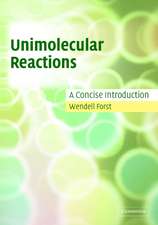Electron Paramagnetic Resonance of Exchange Coupled Systems
Autor Alessandro Bencini, Dante Gatteschien Limba Engleză Paperback – 16 dec 2011
Preț: 388.52 lei
Nou
Puncte Express: 583
Preț estimativ în valută:
74.35€ • 77.34$ • 61.38£
74.35€ • 77.34$ • 61.38£
Carte tipărită la comandă
Livrare economică 15-29 aprilie
Preluare comenzi: 021 569.72.76
Specificații
ISBN-13: 9783642746017
ISBN-10: 3642746012
Pagini: 304
Ilustrații: X, 287 p.
Dimensiuni: 155 x 235 x 16 mm
Greutate: 0.43 kg
Ediția:Softcover reprint of the original 1st ed. 1990
Editura: Springer Berlin, Heidelberg
Colecția Springer
Locul publicării:Berlin, Heidelberg, Germany
ISBN-10: 3642746012
Pagini: 304
Ilustrații: X, 287 p.
Dimensiuni: 155 x 235 x 16 mm
Greutate: 0.43 kg
Ediția:Softcover reprint of the original 1st ed. 1990
Editura: Springer Berlin, Heidelberg
Colecția Springer
Locul publicării:Berlin, Heidelberg, Germany
Public țintă
GraduateCuprins
1 Exchange and Superexchange.- 1.1 The Exchange Interaction.- 1.2 Anderson’s Theory.- 1.3 Molecular Orbital Exchange Models.- 1.4 Quantitative MO Calculations of Singlet-Triplet Splitting.- 2 Spin Hamiltonians.- 2.1 The Spin Hamiltonian Approach.- 2.2 The Magnetic Spin-Spin Interaction.- 2.3 The Exchange Contribution.- 2.4 Biquadratic Terms.- 2.5 Justification of the Spin Hamiltonian Formalism.- 2.6 Exchange Involving Degenerate States.- 2.7 Exchange in Mixed Valence Species.- 3 Spectra of Pairs.- 3.1 The Spin Hamiltonian for Interacting Pairs.- 3.2 Spin Levels in the Strong Exchange Limit.- 3.3 Spectra of Pairs in the Strong Exchange Limit.- 3.4 Spin Levels in the Weak Exchange Limit.- 3.5 Spectra of Pairs in the Weak Exchange Limit.- 3.6 Intermediate Exchange.- 4 Spectra of Clusters.- 4.1 The Spin Hamiltonian for Oligonuclear Systems of Interacting Spins.- 4.2 Spin Levels of Exchange Coupled Clusters in the Strong Exchange Limit.- 4.3 EPR Spectra of Exchange Coupled Clusters in the Strong Exchange Limit.- 5 Relaxation in Oligonuclear Species.- 5.1 Introduction.- 5.2 Theoretical Basis of Spin Relaxation in Pairs.- 5.3 Iridium (IV) Pairs.- 5.4 Copper Pairs.- 5.5 Two-Iron-Two-Sulfur Ferredoxins.- 5.6 Relaxation in Larger Clusters.- 6 Spectra in Extended Lattices.- 6.1 Exchange and Dipolar Interactions in Solids.- 6.2 Exchange Narrowing.- 6.3 Additional Broadening Mechanisms.- 6.4 Exchange Narrowing in Lower Dimensional Systems.- 7 Selected Examples of Spectra of Pairs.- 7.1 Early Transition Metal Ion Pairs.- 7.2 Copper Pairs.- 7.3 Heterometallic Pairs.- 7.4 Organic Biradicals.- 8 Coupled Transition-Metal Ions-Organic Radicals.- 8.1 Introduction.- 8.2 Nitroxides Directly Bound to Metal Ions.- 8.3 Weak Exchange with Nitroxides.- 8.4 Semiquinones.- 9 Biological Systems.-9.1 Introduction.- 9.2 Copper Proteins.- 9.3 Iron Proteins.- 9.4 Exchange-Coupled Species in the Photosynthetic O2-Evolving Complexes.- 10 Low Dimensional Materials.- 10.1 Linear Chain Manganese(II).- 10.2 Linear Chain Copper(II).- 10.3 Two-Dimensional Manganese(II).- 10.4 Two-Dimensional Copper(II).- 11 Excitons.- 11.1 Introduction.- 11.2 Excitons.- 11.3 EPR of Triplet Excitons in Linear Organic Radical Systems.- Appendix A. Second Quantization.- Appendix B. Properties of Angular Momentum Operators and Elements of Irreducible Tensor Algebra..- B.1 Properties of Angular Momentum Operators.- B.2 Addition of Two Angular Momenta. Clebsch-Gordon Coefficients and “3j” Symbols.- B.2.1 Definitions.- B.2.1.1 Equivalent Definitions.- B.2.1.2 Phase Convention and Properties.- B.2.1.3 The “3J” Symbols.- B.2.2 Methods of Calculations.- B.2.2.1 Special Formulae.- B.3 The “6j” Symbols and the Racah W Coefficients.- B.3.1 Definitions.- B.3.2 Properties.- B.3.3 Methods of Calculation.- B.3.3.1 Special Formulae.- B.4 The “9j” Symbols.- B.4.1 Definition.- B.4.2 Properties.- B.4.3 Special Formulae.- B.5. Irreducible Tensor Operators.- B.5.1 Definitions.- B.5.1.1 Compound Irreducible Tensor Operators.- B.5.1.2 Tensor Product of Two First-Rank Irreducible Tensor Operators.- B.5.2 Properties of Irreducible Tensor Operators.- B.5.3 Reduced Matrix Elements of Special Operators.











